It's waiting for you: The most successful Aurora Photo Tour on Earth! 100% success rate 4 years in a row and winner of the TripAdvisor Certificate of Excellence Award. Join LapplandMedia's aurora tours in Abisko, Swedish Lapland! | | |
SPECIAL WEBCAST: Ever wondered how NASA plans to fly astronauts to Mars? You can find out on June 24th, when the Coca-Cola Space Science Center visits Cape Canaveral for a live webcast about NASA's new Space Launch System. Friday's webcast will include the bone-rattling launch of a mighty Atlas V rocket. The action begins at 7 am EDT. Tune in here!
SUNSPOTS VANISHING, AGAIN: For the second time this month, the solar disk is blank--no sunspots. This image of the sun taken by NASA's Solar Dynamics Observatory on June 23rd shows zero dark cores:
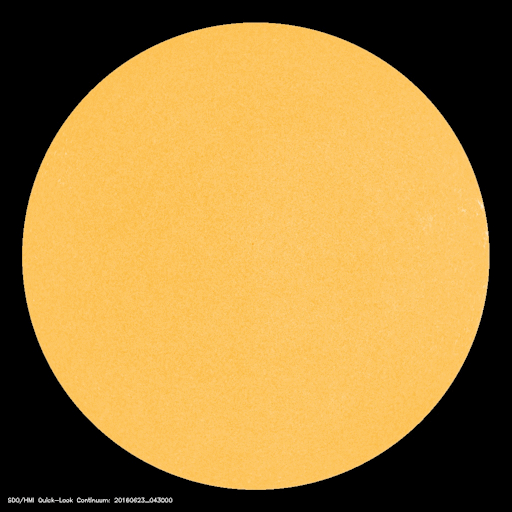
What does this mean? The solar cycle is like a pendulum, swinging back and forth between periods of high and low sunspot number every 11 years. Today's blank sun is a sign that the pendulum is swinging toward low sunspot numbers. In other words, Solar Minimum is coming.
Forecasters expect the next Solar Minimum to arrive in 2019-2020. Between now and then, there will be lots of spotless suns. At first, the blank stretches will be measured in days; later in weeks and months. When the sunspot cycle reaches its nadir, a whole year could go by without sunspots.
However, don't expect space weather to go away. Solar Minimum brings many interesting changes. For instance, as the extreme ultraviolet output of the sun decreases, the upper atmosphere of Earth cools and collapses. This allows space junk to accumulate around our planet. Also, the heliosphere shrinks, bringing interstellar space closer to Earth. Galactic cosmic rays penetrate the inner solar system--and Earth--with relative ease.
Indeed, a cosmic ray surge is already underway . Cosmic rays can seed clouds, trigger lightning, and penetrate commercial airplanes. Our measurements show that someone flying back and forth across the continental USA, just once, can absorb as much ionizing radiation as 2 to 5 dental X-rays. This exposure will increase as Solar Minimum deepens.
Realtime Space Weather Photo Gallery
MIDNIGHT SUN AND MOON: Imagine seeing the sun and the full Moon ... simultaneously ... at the stroke of midnight ... on the summer solstice. It happened last night inside the Arctic Circle. Göran Strand photographed them both on June 21st from Gällivare, Sweden:
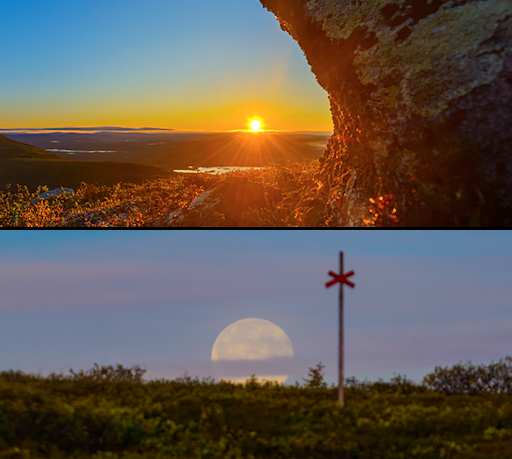
"Seeing the Midnight Sun is really special," says Strand. "After I photographed the sun, I turned around and there was the Moon, too! It was quite awesome to be able to see both the sun and the full Moon during the night."
This is a coincidence that doesn't happen often. It's been decades since the full Moon fell on the night of the solstice, joining the sun as a midnight herald of summer. Strand was in the right place at the right time for a truly unique moonshot. Browse the gallery for more.
NOCTILUCENT CLOUDS IN MOTION: On June 21st, the first night of summer, a fantastic display of noctilucent clouds (NLCs) appeared over Alberta, Canada. "They were the brightest I have ever seen," reports photographer Derek Mellott from the town of Gibbons. "It seemed like a good time to record a time lapse." Click on the arrow to set the scene in motion:
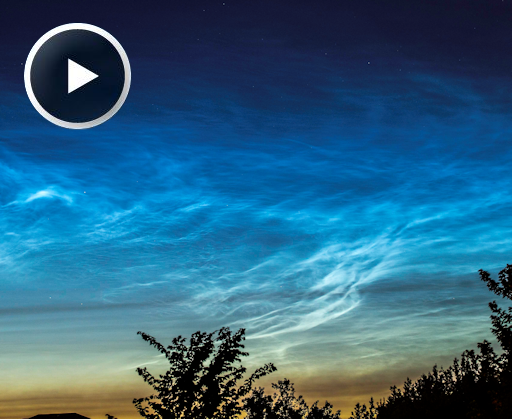
Mellott's video shows the almost hypnotic motions of the cloud's finely-structured ripples. "It was amazing," he says. Indeed, no other kind of cloud moves like an NLC, which twists and turns in the unique winds at the edge of space.
Noctilucent clouds are a true space weather phenomenon. They assemble more than 80 km above Earth's surface where diaphanous wisps of summertime water vapor wrap themselves around meteoroids to form tiny ice crystals. Long ago, they were confined to Arctic latitudes. As a result of climate change, they are now brightening and spreading, with sightings in recent years as far south as Colorado and Kansas.
Observing tips: Look west 30 to 60 minutes after sunset when the sun has dipped 6o to 16o below the horizon. If you see luminous blue-white tendrils spreading across the sky, you may have spotted a noctilucent cloud.
Realtime Noctilucent Cloud Photo Gallery
Realtime Sprite Photo Gallery
Realtime Aurora Photo Gallery
Realtime Comet Photo Gallery
Every night, a network of
NASA all-sky cameras scans the skies above the United States for meteoritic fireballs. Automated software maintained by NASA's Meteoroid Environment Office calculates their orbits, velocity, penetration depth in Earth's atmosphere and many other characteristics. Daily results are presented here on Spaceweather.com.
On Jun. 23, 2016, the network reported 12 fireballs.
(12 sporadics)
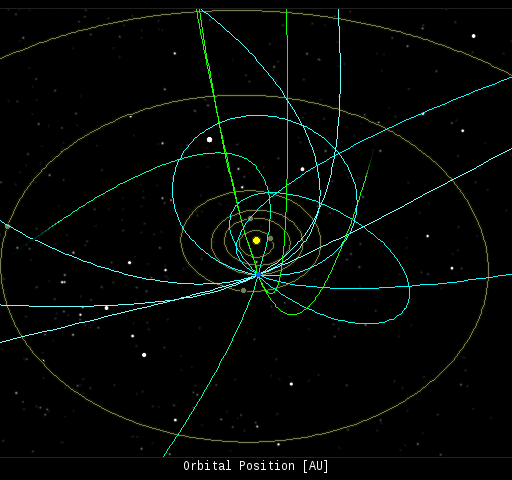
In this diagram of the inner solar system, all of the fireball orbits intersect at a single point--Earth. The orbits are color-coded by velocity, from slow (red) to fast (blue). [Larger image] [movies]
Potentially Hazardous Asteroids (
PHAs) are space rocks larger than approximately 100m that can come closer to Earth than 0.05 AU. None of the known PHAs is on a collision course with our planet, although astronomers are finding
new ones all the time.
On June 23, 2016 there were potentially hazardous asteroids.
Notes: LD means "Lunar Distance." 1 LD = 384,401 km, the distance between Earth and the Moon. 1 LD also equals 0.00256 AU. MAG is the visual magnitude of the asteroid on the date of closest approach. | | Cosmic Rays in the Atmosphere |
| Situation Report -- Oct. 30, 2015 | Stratospheric Radiation (+37o N) |
| Cosmic ray levels are elevated (+6.1% above the Space Age median). The trend is flat. Cosmic ray levels have increased +0% in the past month. |
| Sept. 06: 4.14 uSv/hr (414 uRad/hr) |
| Sept. 12: 4.09 uSv/hr (409 uRad/hr) |
| Sept. 23: 4.12 uSv/hr (412 uRad/hr) |
| Sept. 25: 4.16 uSv/hr (416 uRad/hr) |
| Sept. 27: 4.13 uSv/hr (413 uRad/hr) |
| Oct. 11: 4.02 uSv/hr (402 uRad/hr) |
| Oct. 22: 4.11 uSv/hr (411 uRad/hr) |
These measurements are based on regular space weather balloon flights: learn more. Approximately once a week, Spaceweather.com and the students of Earth to Sky Calculus fly "space weather balloons" to the stratosphere over California. These balloons are equipped with radiation sensors that detect cosmic rays, a surprisingly "down to Earth" form of space weather. Cosmic rays can seed clouds, trigger lightning, and penetrate commercial airplanes. Our measurements show that someone flying back and forth across the continental USA, just once, can absorb as much ionizing radiation as 2 to 5 dental X-rays. For example, here is the data from a flight on Oct. 22, 2015:
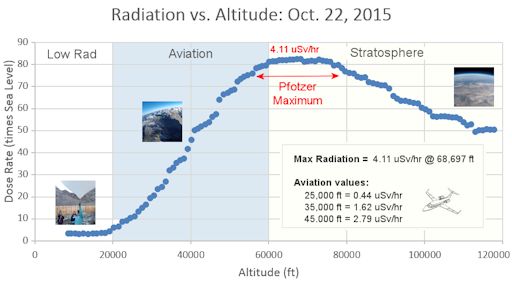
Radiation levels peak at the entrance to the stratosphere in a broad region called the "Pfotzer Maximum." This peak is named after physicist George Pfotzer who discovered it using balloons and Geiger tubes in the 1930s. Radiation levels there are more than 80x sea level.
Note that the bottom of the Pfotzer Maximim is near 55,000 ft. This means that some high-flying aircraft are not far from the zone of maximum radiation. Indeed, according to the Oct 22th measurements, a plane flying at 45,000 feet is exposed to 2.79 uSv/hr. At that rate, a passenger would absorb about one dental X-ray's worth of radiation in about 5 hours.
The radiation sensors onboard our helium balloons detect X-rays and gamma-rays in the energy range 10 keV to 20 MeV. These energies span the range of medical X-ray machines and airport security scanners.
| | The official U.S. government space weather bureau |
| | The first place to look for information about sundogs, pillars, rainbows and related phenomena. |
| | Researchers call it a "Hubble for the sun." SDO is the most advanced solar observatory ever. |
| | 3D views of the sun from NASA's Solar and Terrestrial Relations Observatory |
| | Realtime and archival images of the Sun from SOHO. |
| | from the NOAA Space Environment Center |
| | the underlying science of space weather |
 | Tobi -- Proud Supporter of Space Education! |
 | Claim your tax refund with this UK tax rebate company and get back your overpaid tax. |
 | Enjoy this fabulous range of leather sofas from a leader in the UK sofa manufacturer industry.. |

